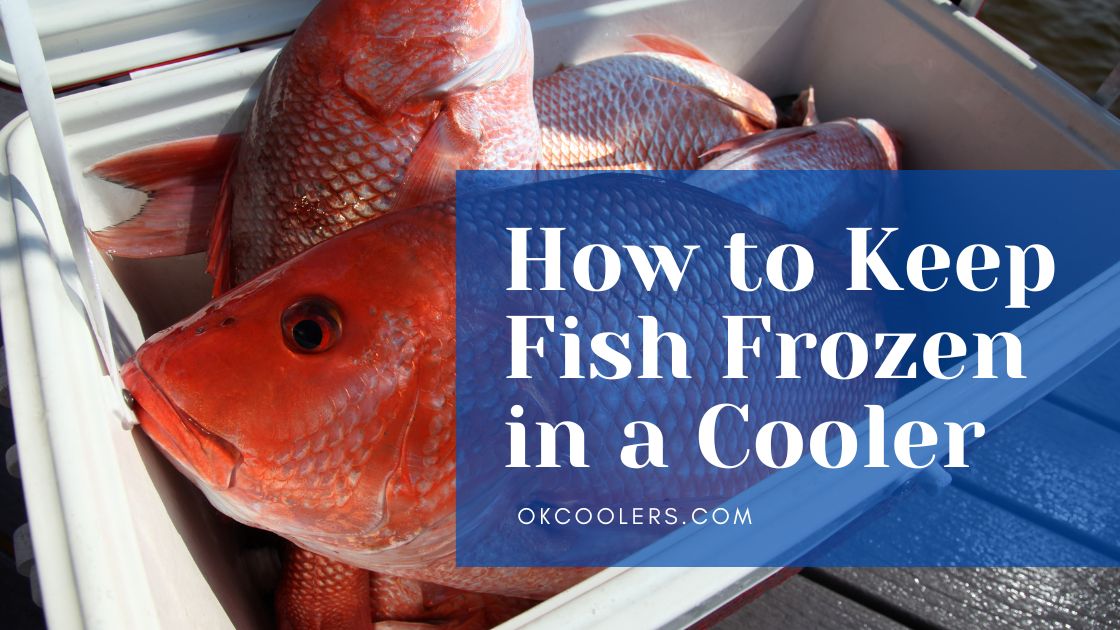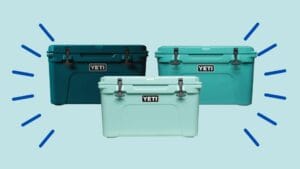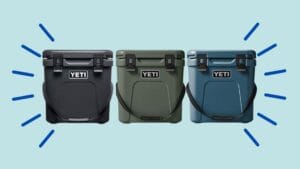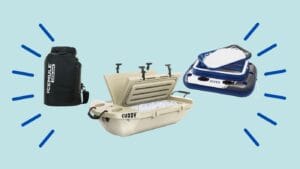How to Keep Fish Frozen in a Cooler? Imagine this, you’ve spent a long day out on the water, casting your line and reeling in the perfect catch. The sun is beginning to set, and you can already taste the delicious meal that awaits you. But there’s one problem – how do you keep your freshly caught fish frozen until you’re ready to cook?
Keeping fish frozen in a cooler can be challenging, especially if you’re planning to transport them over a long distance. But fear not, fellow anglers! We’ve gathered the best tips and techniques to help you preserve your prized catch, ensuring that it stays fresh and frozen until you’re ready to enjoy it.
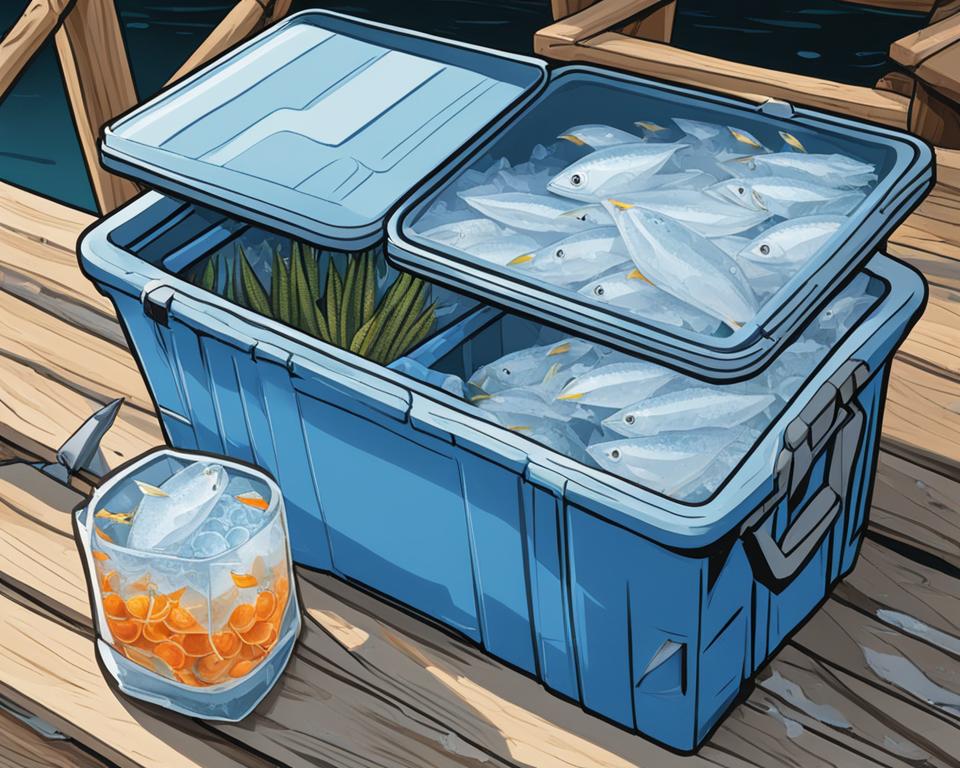
Fish storage in a cooler requires careful planning and preparation. From choosing the right cooler to using the best freezing methods, these essential tips will ensure that your fish remains frozen and perfectly preserved for your culinary delight.
How to Keep Fish Frozen in a Cooler – Key Takeaways:
- Choose a thick-walled cooler to provide better insulation and maintain a consistent temperature.
- Use dry ice for the best freezing results, as it prevents ice crystals from forming and maintains a low temperature.
- Insulate the fish with newspaper or packing paper, creating holes to allow dry ice vapors to penetrate effectively.
- If dry ice is unavailable, use alternative methods such as crushed ice and Ziplock freezer bags or super-chilling the fish on ice in a well-insulated cooler.
- Properly freeze and package the fish using aluminum foil, cling wrap, or zipper-lock freezer bags, and label the package with relevant information.
Why Dry Ice is the Best Method
Dry ice is a highly effective method for freezing fish in a cooler. Its unique properties make it the go-to choice for anglers looking to preserve their catch. Here’s why dry ice is considered the best option:
- Prevents ice crystals: Unlike traditional ice, dry ice prevents the formation of ice crystals on the fish. Ice crystals can damage the texture and quality of the fish, resulting in a less enjoyable eating experience.
- Maintains low temperature: Dry ice has an average temperature of around -109.3 degrees Fahrenheit, ensuring a consistently low temperature in the cooler. This helps to keep the fish frozen for an extended period, allowing anglers to store their catch for longer durations.
- Rapid freezing: Due to its extremely cold temperature, dry ice freezes fish quickly. This quick freezing process helps to preserve the freshness and flavor of the fish, ensuring that it retains its quality when thawed.
- Long freezing duration: One of the significant advantages of using dry ice is its extended freezing duration. The fish can remain frozen for up to 24 hours with the help of adequate insulation and proper storage techniques.
Before placing the fish in the cooler, it is crucial to store them correctly. To prevent the fish from coming into direct contact with dry ice, it is advisable to use either a vacuum-sealed plastic bag or a plastic zipper-style freezer bag for added protection.
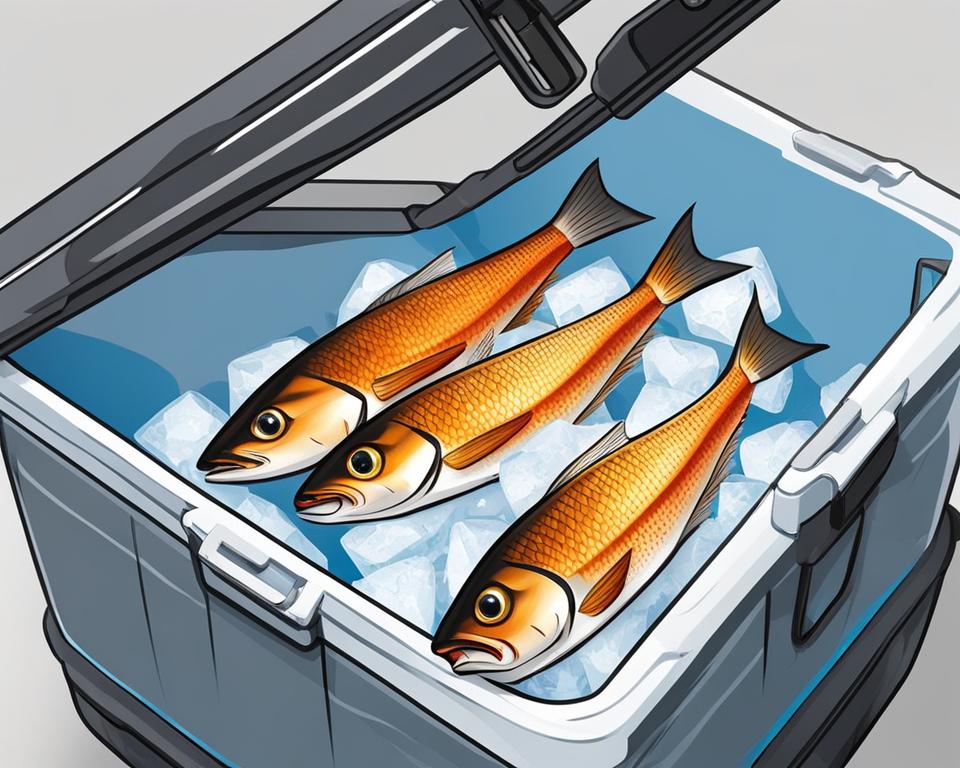
How to Keep Fish Frozen in a Cooler – Choosing the Right Cooler
When transporting fish in a cooler, it is important to choose the right cooler. Thin-walled Styrofoam coolers do not provide sufficient insulation and may crack or break easily. Instead, opt for a thicker cooler that is two to four inches thick. This will provide better insulation and help maintain a consistent temperature for your fish storage in cooler.
When selecting a cooler, consider the size and capacity based on the amount of fish you plan to store. A larger cooler may be necessary for larger catches or longer trips.
In addition to insulation, ensure that there is no water or other liquids in the cooler that could affect the freezing or storage process. It is crucial to keep your fish dry to maintain their quality and prevent any potential contamination.
Remember, the right cooler is essential for preserving the freshness and integrity of your catch, so choose wisely.
Comparison of Cooler Types
| Cooler Type | Insulation Thickness | Pros | Cons |
|---|---|---|---|
| Thin-walled Styrofoam | 1 inch or less | – Lightweight and affordable – Easy to dispose of after use | – Insufficient insulation – Prone to cracking or breaking |
| Thick-walled Cooler | 2 to 4 inches | – Provides better insulation – Maintains consistent temperature | – Heavier and bulkier – Higher cost |
Choose a cooler that best fits your needs and ensures optimal fish storage in cooler conditions.
Proper Insulation Techniques
Proper insulation techniques are crucial for effective cooler storage of fish and preserving their freshness. By following these essential techniques, you can ensure that your fish remains frozen and in optimal condition during transportation or longer storage periods.
Insulating with Newspaper or Packing Paper
To insulate the fish, use newspaper or packing paper that has 10-15 small holes poked in it. These holes allow the dry ice vapors to penetrate, ensuring effective freezing. The insulating paper should be placed between the fish and the dry ice to prevent any superficial freezer burn. This method is ideal for maintaining the quality of the fish and preventing any damage caused by direct contact with dry ice.
Placement of Dry Ice
If you need to keep the fish frozen, place the dry ice on top of the fish, ensuring that the insulating paper is between the dry ice and the fish. This arrangement helps in maintaining a consistently low temperature and ensures that the fish remain frozen throughout the storage period. However, if you only need to keep the fish cold instead of frozen, place the dry ice at the bottom of the cooler with the fish on top. This method allows for the fish to be kept at a cooler temperature without freezing them completely.
Handling Dry Ice with Safety Precautions
When using dry ice, it is essential to prioritize safety and wear protective gloves during handling. Dry ice is extremely cold and can cause frostbite if it comes into direct contact with skin. By taking these safety precautions, you can effectively preserve your fish while keeping yourself safe.
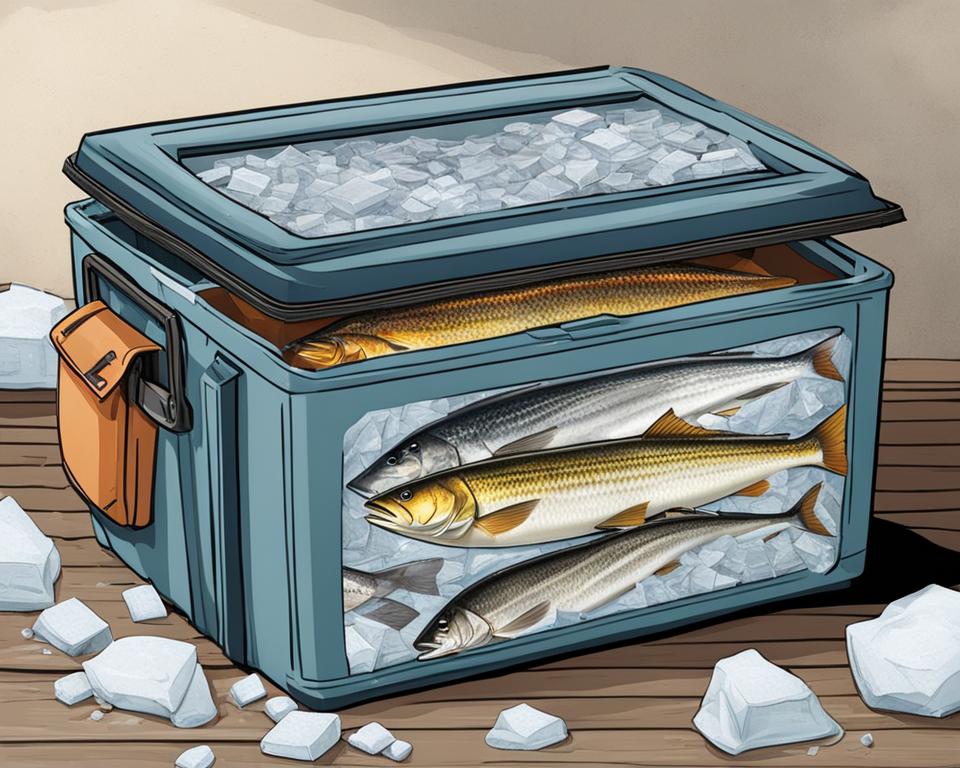
| Benefits of Proper Insulation Techniques |
|---|
| Prevents freezer burn and damage to fish |
| Maintains a consistently low temperature for optimal fish preservation |
| Allows for customized temperature control based on fish storage needs |
| Ensures safe handling of dry ice during the storage process |
How to Keep Fish Frozen in a Cooler – Alternative Freezing Methods
In situations where dry ice is not available, there are alternative methods for preserving fish in a cooler. These methods ensure that your catch stays fresh and frozen, ready to be enjoyed at a later time. Here are two effective techniques:
Method 1: Using Crushed Ice with Ziplock Freezer Bags
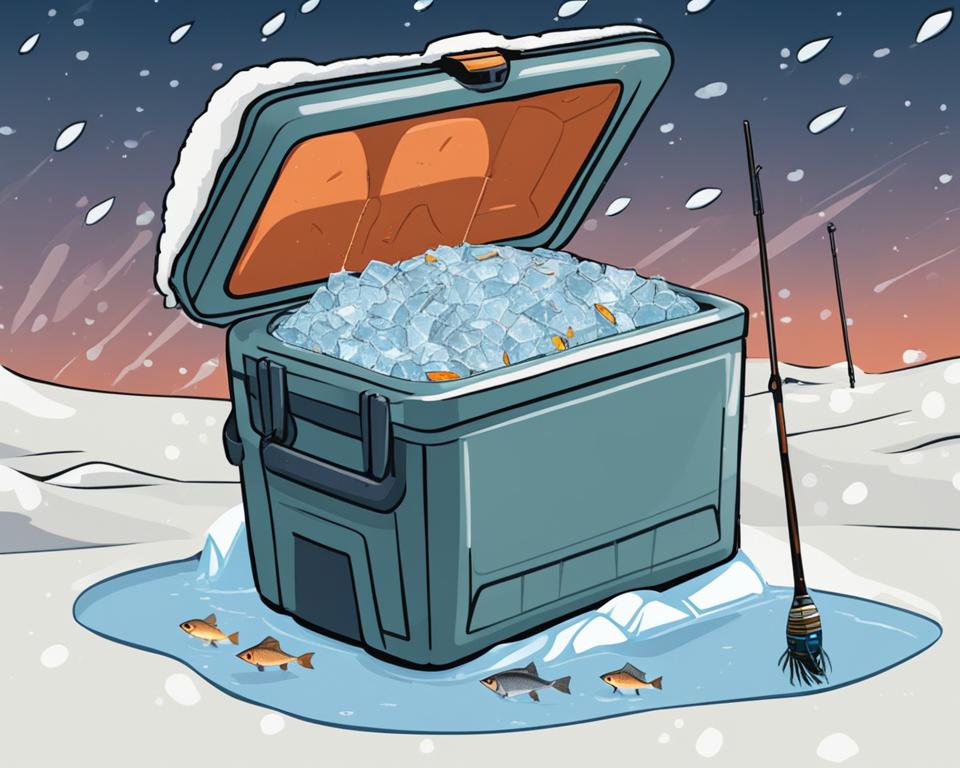
One option is to use crushed ice and layer the fish in Ziplock freezer plastic bags. Start by placing a layer of crushed ice at the bottom of the bag, then add a single layer of fish fillets or whole fish. Repeat this process until the bag is full, ensuring each layer is separated by a layer of crushed ice. Add water to cover the fish completely, ensuring they are submerged. Seal the bag tightly, removing any excess air, and freeze it solid. This method helps maintain the low temperature necessary for fish storage in a cooler.
Method 2: Super-Chilling with Ice in a Well-Insulated Cooler
Another method involves packing the fish tightly on ice in a well-insulated cooler. Start by arranging a layer of ice at the bottom of the cooler. Place the fish on top of the ice, making sure they are tightly packed to minimize air exposure. Add more ice to completely cover the fish and seal the cooler. The insulation provided by the cooler combined with the ice helps super-chill the fish and keep them fresh. Properly stored fish can be kept on ice using this method for up to five days, allowing for longer trips or prolonged storage.
Remember, immediately gutting the fish after catching them is crucial to prevent deterioration of the flesh and preserve fish quality.
Comparison of Freezing Methods
| Method | Benefits | Limitations |
|---|---|---|
| Using Crushed Ice with Ziplock Freezer Bags | – Easy to implement with readily available materials – Suitable for individual portions of fish | – Requires access to crushed ice – Ziplock bags may not provide the same level of insulation as other methods |
| Super-Chilling with Ice in a Well-Insulated Cooler | – Effective for longer storage periods – Ideal for larger quantities of fish | – Requires a well-insulated cooler to maintain low temperatures – Limited to the availability of ice during the trip |
Choosing the right method depends on your specific circumstances and the availability of resources. Both methods offer practical alternatives for preserving fish in a cooler when dry ice is not an option.
Proper Freezing and Packaging Techniques
To ensure the quality and flavor of your frozen fish, it is crucial to follow proper freezing and packaging techniques. Begin by using appropriate packaging materials such as aluminum foil, cling wrap, or zipper-lock freezer bags. These materials will help seal in moisture and prevent air and oxygen from reaching the fish, keeping it fresh.
When packaging the fish, be sure to write important information on the outside of the package, including the date it was frozen, the type of fish, and its size. This will allow you to easily identify and manage your frozen fish inventory.
If you plan on storing the fish in a refrigerator for the long term, surround it with crushed ice to maintain a temperature of around 34°F. This will ensure that the fish remains at the optimal temperature for preservation.
When it comes time to thaw the frozen fish, it is important to do so properly. Thaw the fish in the refrigerator or under cold running water. Avoid thawing at room temperature as this can lead to bacterial growth. Refreezing fish that have been thawed at room temperature should also be avoided, as it can negatively affect the quality and safety of the fish.
How to Keep Fish Frozen in a Cooler – FAQ
How can I keep my freshly caught fish frozen in a cooler?
To keep your fish frozen in a cooler, follow these essential tips:
Why is dry ice the best method for freezing fish in a cooler?
Dry ice prevents ice crystals from forming on the fish and maintains a consistently low temperature, making it ideal for freezing fish in a cooler.
What should I consider when choosing a cooler for transporting fish?
It is important to choose a thicker cooler, preferably two to four inches thick, that can provide better insulation and maintain a consistent temperature.
How can I properly insulate the fish in the cooler?
Insulate the fish with newspaper or packing paper with holes poked in it to allow dry ice vapors to penetrate and freeze the fish effectively. Place the dry ice on top of the fish with insulating paper in between to prevent freezer burn.
What alternative methods can I use for freezing fish in a cooler?
If dry ice is not available, you can use crushed ice and layer the fish in Ziplock freezer bags, or pack the fish tightly on ice in a well-insulated cooler.
What are some proper freezing and packaging techniques for fish in a cooler?
Use appropriate packaging materials such as aluminum foil, cling wrap, or zipper-lock freezer bags to seal in moisture and prevent air and oxygen from reaching the fish. Label the package with the date frozen, fish type, size, and any other relevant information.

